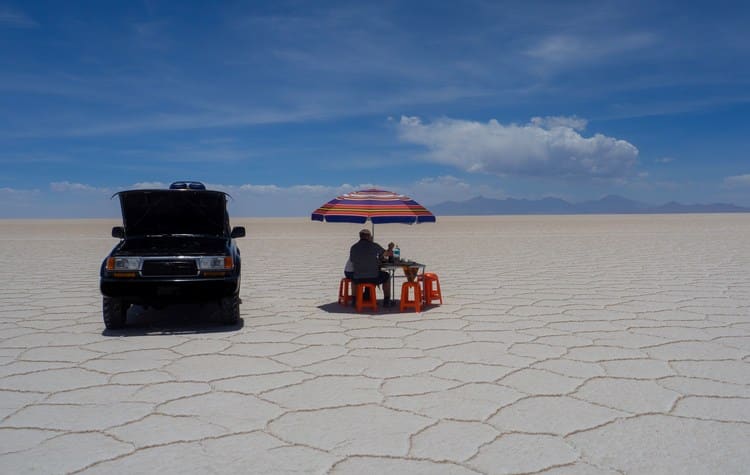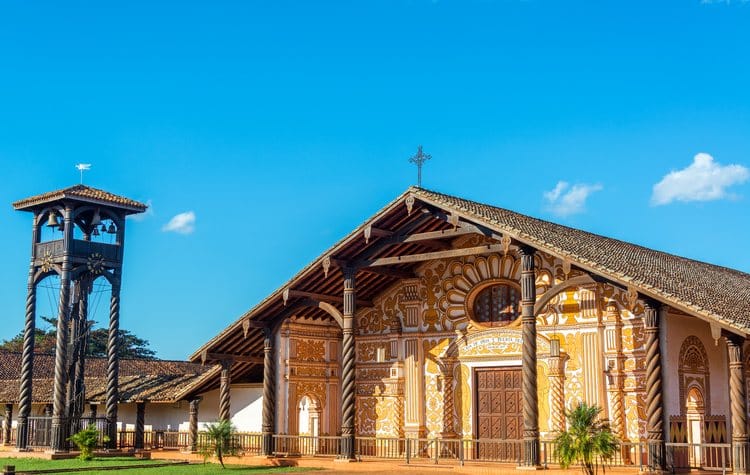
From coasting down one of the most dangerous roads in the world to descending narrow tunnels in the country’s deepest canyon, Bolivia is not for the faint of heart. Of course, this rugged country is ripe with natural beauty and culinary traditions that are worth pressing pause on other adrenaline-driven activities. Experienced and knowledgeable, Kuoda travel designers can create a custom-made itinerary for your Bolivia journey— no matter if you lean more towards luxury travel than immersive local experiences, or perhaps a combination of the two.
Meant to inspire, the following top 12 things to see and do in Bolivia will likely awaken your desire to experience something new and exciting. Take a look and contact us when you have selected the experiences you wish to include in your 2023 Bolivia adventure:
1. Cycle El Camino de la Muerte

Only avid cyclists and thrillseekers will dare to complete this 40-mile, high-altitude route along the North Yungas Road. Referred to by Bolivianos as El Camino de la Muerte (Death Road), this adventure attracts thousands of international bikers every year who quickly learn that their eyes are not to be taken off the road— no matter how breathtaking the subtropical valley landscapes.
Beginning at 15,400 feet in La Paz (the highest capital in the world), bikers will cruise down a winding, 3-meter wide road to reach Coroico (just over 5000 feet). It’s quite a drop in elevation, which means cyclists are squeezing the brakes nearly constantly. Sound like your kind of adrenaline rush? Kuoda travel designers can match you with an experienced and safe guide for your mountain bike experience.
2. Airstream Adventure in the

The Bolivian salt flats Salar de Uyuni are the largest of its kind in the world, covering over 3,900 square miles. Located in southwest Bolivia, the salt flats are the most popular tourist destination in the Andean country— but not every traveler gets the opportunity to experience Salar de Uyuni on a luxury South America journey.
Parked within eyesight of the salt flats, a deluxe Airstream camper will be your stylish and comfortable base as you explore Salar de Uyuni. Set out by foot or 4WD (four-wheel drive) to explore nearby lagoons, desert and Andean flamingos, only to return to a private Airstream camper. Complete with a shower, heating and sofa space, your personal Airstream also offers impeccable sunrise and sunset views over the salt flats.
3. El Choro Trail

Located near La Paz, El Choro is part of the multi-country Inca trail. The ingenious ancient culture once used these paths to transport subtropical goods up into the mountains. Nowadays, the popular route is followed in the opposite direction, with hikers descending some 10,000 feet.
Beginning at La Cumbre pass (15,000 feet) in the Andes Mountain range, hikers will walk in the footsteps of the Incas as they make their way from high mountains into the cloud forest and eventually the beautiful, sub-tropical village of Chairo.
One of the most popular hiking trails in La Paz, the extensive El Choro trail is typically completed in 2-3 days. Accompanied by a local guide that has been hand-selected by Kuoda, you will follow pre-Columbian stone paths and witness the change in stunning natural scenery and vegetation. This downward hike is not for travelers with knee problems.
4. Torotoro, Bolivia’s Jurassic Park

Can you imagine coming across thousands of dinosaur footprints in the Eastern Cordillera of the Andes in Bolivia, some dating as far back as 140 million years? A visit to the remote Torotoro National Park on a custom-made trip is your chance to feel like an amateur paleontologist as local guides point to sharp and round-toed huellas (footprints) and the types of dinosaurs that once roamed the area.
Besides the 3,500+ dinosaur footprints, Torotoro is an exciting destination for travelers of all interests who are eager to experience something unique and authentic. Once submerged underwater, the valley today is characterized by surreal landscapes and colorful earthen hues. An 820-foot canyon welcomes hikers into its depths from where magnificent winged creatures such as the Andean condor soar above.
5. Bolivian Pampas

If looking to spot as much wildlife as possible, head to the Bolivian pampas— a wetland savannah area where local fauna prance, flutter and scurry in the absence of trees. On a private journey with Kuoda, you will participate in ecotourism in the Pampas del Yacuma. This is a journey that will amaze you with the variety of easy-to-see animals while simultaneously presenting the opportunity to have a positive impact on the conservation of this protected area through travel.
Travelers will fall in love with the thriving wildlife observed in the plains along the Yacuma River as well as the lagoons in the Beni savannah. Upon a motorized canoe, you will cruise through this unique Amazonian savannah to spot black caiman, yellow-spotted river turtle and gray brocket deer. Accompanied by a private tour guide, we will also help you spot endemic and endangered wildlife such as the Beni and Olalla titi monkeys and the blue-throated macaw.
6. Go caving in Umajalanta

Filled with stalagmites, stalactites and underground waterfalls, the Umajalanta cavern is nearly 3 miles long and over 530 feet deep, making it one of the longest and deepest caves in Bolivia. Umajalanta (also written as two words, Uma Jalanta) is Quechua for “water lost in the darkness of the deepest earth,” and there is in fact water running through the cave.
Located in the Torotoro National Park, adventure travelers will be elated to walk, climb and crawl their way through a network of narrow tunnels. Strapped with headlamps and guided by a certified guide, exploring the Caverna de Umajalanta is a thrilling Bolivia experience that ends at an underground lake filled with blind catfish. Visitors will be happy to know the walk back to the entrance is much more direct.
7. Swim in waterfalls at Amboro National Park

A jungle paradise, the Amboro National Park covers an area of 1,709 square miles in a region known as the ‘elbow of the Andes’ (at the junction of eastbound and northbound mountains). The north side of the park sees fewer tourists and, consequently, is brimming with mystery lurking in the thick foliage for travelers seeking an Indiana Jones-inspired journey.
Tucked in the vast greenery are streams and cascading waterfalls that give way to refreshing natural pools. Lured by its crystal clear water, consider rappelling down the Jardin de las Delicias waterfall for an adrenaline rush that ends with a soothing splash.
The Amboro National Park was created to protect one of the most biodiverse regions in Bolivia, and guests of Kuoda can be sure that their meaningful journey into this natural area will have been responsibly designed.
8. Visit the UNESCO Jesuit Missions

When Jesuit missionaries first arrived in Bolivia in 1572, the South American country was then referred to as Upper Peru. Working in remote jungle and mountain towns of Bolivia, the missionaries drew locals to build their adobe and thatch roof homes around wooden carved churches with gold leaf. Many of the humble homes and pitched roof churches can be seen today, the latter having been restored and now protected by UNESCO.
Graceful and incredibly detailed, travelers on a custom-made trip can step inside the Jesuit missionary churches and be awed by the grandiose style of the worship centers found in isolated and rural villages. The surrounding population remains largely indigenous, and your visit with Kuoda is one way to support local communities.
9. Trek historic Inca Trails

Peru is top of mind when it comes to Inca Trails, but did you know that Bolivia is also brimming with opportunities to walk in the footsteps of the Incas? Playing a pivotal role in the history of South America, portions of Qhapaq Ñan (the Quechua name for the iconic road system) run through Bolivia and make for a stunning day hike for travelers on a personalized journey.
What once served as a vital communication and trade network, the Inca Trail in Bolivia connects the Andes with the Pacific Coast, crossing through jungle and valleys along the way. Beginning in Chataquila, near Sucre, you will enjoy a relaxed 3.5-mile walk to the village of Chaunaca. Unlike the famous Inca Trail trek in Peru, the Bolivia portion is generally downhill and far less crowded.
10. Explore the Cerro Rico Mine

Located near the city of Potosí, in the southern highlands of Bolivia, the Cerro Rico (Rich Mountain) is a 15,800-foot mountain that has been mined for its silver since the arrival of Spanish conquistadors. Having provided vast quantities of silver to the Spanish Empire, Cerro Rico has a dark history that has gained it the nickname of “the mountain that eats men” as the work conditions are incredibly risky.
As potential consumers of silver and precious metals, responsible travelers will find this Bolivia experience to be incredibly eye-opening. That is why Kuoda offers this Cerro Rico experience as part of our dedication to ethical tourism. By partaking in the social tour of the infamous Bolivian mine, led by a respectful and knowledgeable guide, you are able to provide an alternative source of income to local miners that often have no other choice of earning income.
11. Hike through Bolivias Grand Canyon

Palca Canyon lies just east of Bolivia’s capital city La Paz, making this Bolivia bucket list item ideal as a half day adventure. Exquisite rock formations stretch nearly 5 miles long— far shorter than the Grand Canyon’s impressive 273 miles, and yet Palca is often likened to the Arizona landmark. A flat road at the bottom of the canyon invites visitors to spend a few hours hiking and admiring the views of mountains and wildlife.
While drenched in sunlight, spot the snow capped Illimani mountain (part of the Cordillera Real mountain range) and rock formations that look like gothic cathedrals. During the two-hour trek, keep your eyes peeled for the mountain caracara, a species of falcon that is thought to bring good luck. Nearby is the slightly spooky Valle de las Animas, which your Kuoda travel designer can add to the day’s personalized itinerary.
12. Sample traditional Bolivian food in Cochabamba

In the heart of the Bolivian valleys, Cochabamba is a must-visit destination for foodies seeking authentic travel experiences. Traditional dishes nourish locals of Bolivia’s third largest city, despite the area’s ongoing expansion and development. A large population of students and young professionals keep this 2,600-masl city abuzz and, as a result, avenues of restaurants and bars make for a satiating food tour.
Though it may look and sound simple, arroz con queso (rice with cheese) is the epitome of Bolivian comfort food. You will likely try the rich rice dish served alongside churrasco (grilled steak). Street food in Cochabamba is a thrilling and tasty way to eat like the locals do, so when you see a stand serving anticuchos (grilled cow heart on skewers) or the national snack salteñas (dough pockets typically filled with chicken or beef), step right up and place your order!
Peru’s Northern Beaches Travel Guide: Your Adventure-Filled Getaway
Bask in the northern BEACHERGOER’S PARADISE, With its dependable year-round sunshine, pristine coastline, s...
Read PostThe Most Eco-Friendly Hotels in South America For The Responsible Traveler
For the eco friendly hotels in South America, responsible travel in hospitality is not just a trend but a nece...
Read PostExplore Peru’s Sacred Valley: A Journey Through Incan Wonders
Experience a land BLESSED BY INCAS, Tucked away in the Andean foothills of Peru lies the historic Sacred Vall...
Read Post

 Call
Call 























